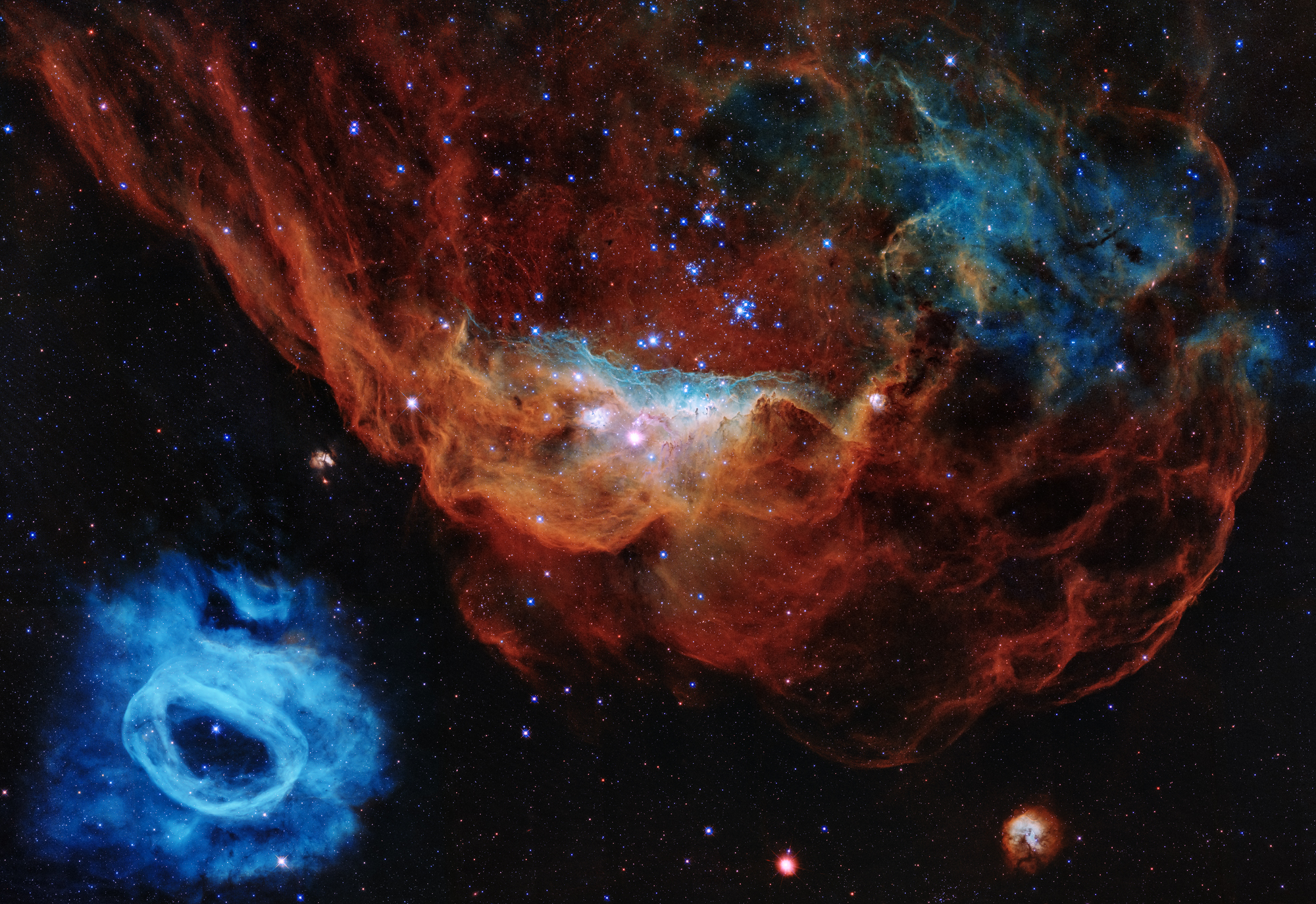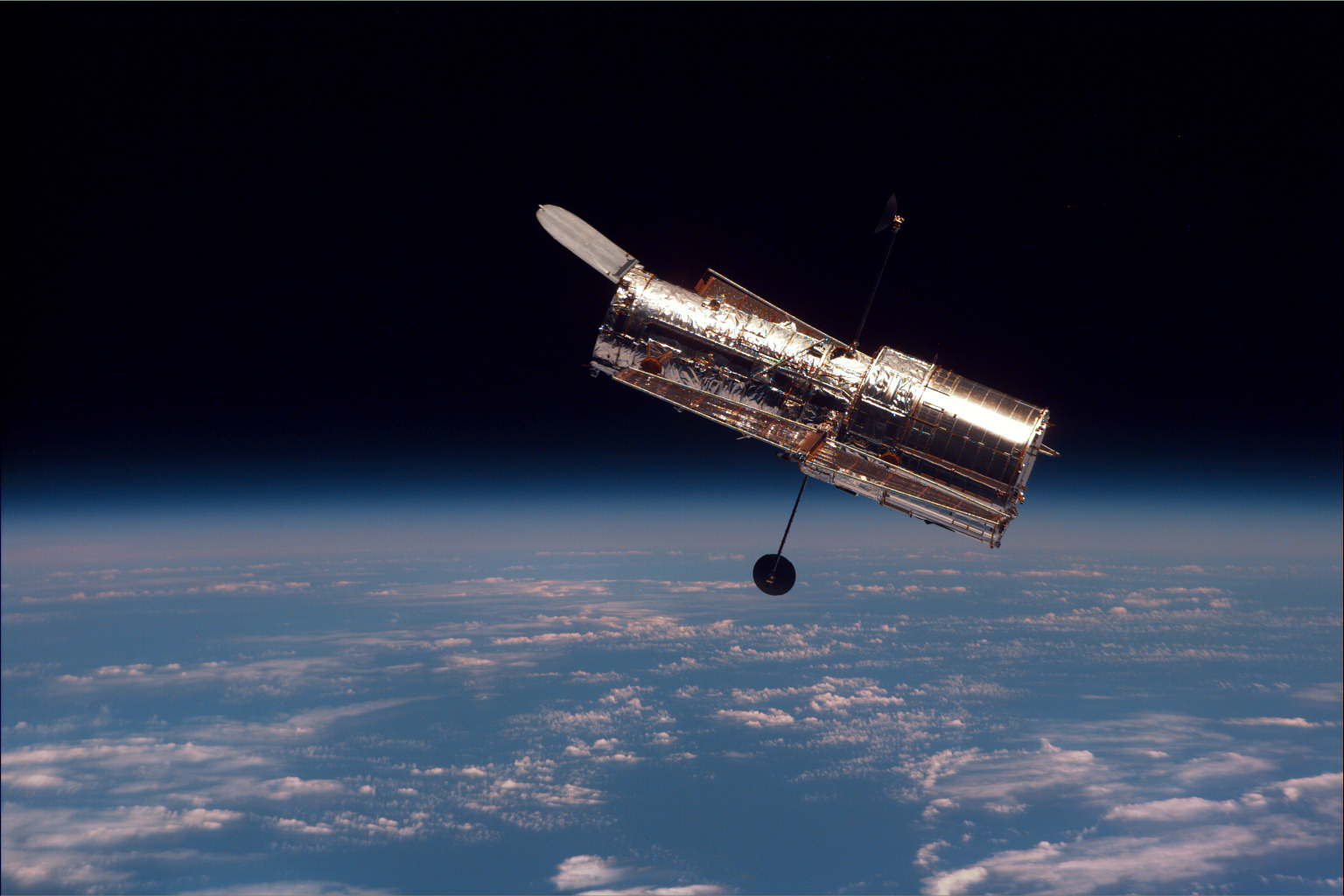Hubble captures a 'Cosmic Reef' in stunning 30th anniversary image
"This image is amazing, it's really showing how powerful Hubble is."

With a captivating new photo, the "Cosmic Reef," NASA's Hubble Space Telescope showcases the instruments' incredible capabilities on its 30th anniversary.
Thirty years ago today (April 24), Hubble launched into space on a mission to open humanity's eyes to the wonders of the cosmos. In a new Hubble image released today, the telescope captured two neighboring clouds of cosmic dust and gas: the giant red nebula NGC 2014 and a smaller blue nebula nearby called NGC 2020.
Hubble scientists named the image "Cosmic Reef," because the sparkling, brilliant structures resemble a cosmic coral reef glistening in some secret corner of a deep ocean. This image was taken by Hubble's Wide Field Camera 3 to mark the telescope's 30 years in space.
"This image is amazing, it's really showing how powerful Hubble is," Elena Sabbi, an astrophysicist at the Space Telescope Science Institute, told Space.com. "Today, it has the sharpest eyes it's ever had."
Video: Beautiful nebulas in 'never-before-seen' Hubble 30th anniversary view
Related: The best Hubble Space Telescope images of all time!
These brilliant star birthplaces are part of the much larger star-forming region the Large Magellanic Cloud, a satellite galaxy of the Milky Way about 163,000 light-years away from Earth. NGC 2014 is made up of a shimmering collection of bright stars, each 10 to 20 times more massive than our sun. Meanwhile, NGC 2020 is made up of a single, enormous star that is about 200,000 times brighter than our sun.
NGC 2014 also has that distinct bubbly, coral-like appearance. This is created when massive stars in the nebula release intense stellar winds, or streams of charged particles, that push away lower-density gases, Hubble scientists said in a statement.
Get the Space.com Newsletter
Breaking space news, the latest updates on rocket launches, skywatching events and more!
The large nebula also has a few blue spots which match its smaller neighboring nebula. These blue areas are created by oxygen that has been super-heated by ultraviolet light to about 20,000 degrees Fahrenheit (about 11,093 degrees Celsius).
Since NGC 2020 contains just one brilliant star, its blue tones are created a little bit differently. The blue gas seen in this nebula was ejected by this star during a number of events in which the star blew off part of its outer envelope and released this gas as it reaches the end of its life.
"It is very very hard to be a star in a star cluster," Sabbi said about NGC 2020. "It's 50 times more massive than the sun, has been kicked from the nursery it's now zooming through the Magellanic cloud at 46,000 miles per hour and this star is approaching the end of its life, so it's already losing its external envelope."
Hubble's legacy

This image is a perfect way to commemorate the space telescope's 30th "birthday." The stunning detail captured from 163,000 light-years away shows just how powerful Hubble is.
Since it launched in 1990, the space telescope has made over 1.4 million observations of over 47,000 celestial objects, producing over 164 terabytes of data and leading to over 17,000 scientific papers and counting.
Observations made with Hubble confirmed the existence of supermassive black holes in the centers of galaxies and even led to the discovery of dark energy. Using Hubble observations, scientists were also able to create the best 3D maps of dark matter, showing how the mysterious matter is distributed throughout the universe.
Hubble has discovered some of Pluto's moons and provided new information about protoplanetary disks (the disks of gas and dust that surround a star and form planets and celestial objects) and gamma-ray bursts, the strongest and brightest explosions in the universe. The space telescope has even captured the moment when the comet Shoemaker-Levy 9 collided with Jupiter in 1994.
Hubble's observations have led to an incredible wealth of discovery and exploration. But, even more so than just scientific discovery, the images collected by Hubble opened humanity's eyes to what really lies out in the universe. For the first time, people could see in stunning detail what nebulas look like "up close," or how the planet's in our solar system are patterned with incredible clouds and structures.
"I think, maybe in my opinion, the coolest thing," former NASA astronaut Mike Massimino, who flew on the last two servicing missions to the telescope, recently told Space.com about Hubble, is "it takes us places we could only dream about going and shows us the beauty of the universe that's out there."
Hubble's future
Hubble is still going strong 30 years after it launched. "Hubble is doing great because after we refurbished it 10 years ago, now we have two new cameras and these cameras were built so that everything on them is redundant if something breaks, it means that we can switch on the other side and continue to operate," Sabbi said. "We think that we will probably have another 5 to 10 years and it will give us great discoveries."
They added that soon, the James Webb Space Telescope will soon launch and add to this incredible observing power. "It's a different telescope it will look at different parts of the electromagnetic spectrum so it will give us a different perspective of the properties of stars and galaxies and it will see the early universe. And combining what Hubble can see with this telescope — it will be amazing, we will have a brand new perspective of the universe," Sabbi said.
- Kathy Sullivan on the all-female spacewalk that could have been
- NASA is turning off the Spitzer Space Telescope
- How the Hubble Space Telescope works (infographic)
Follow Chelsea Gohd on Twitter @chelsea_gohd. Follow us on Twitter @Spacedotcom and on Facebook.
OFFER: Save 45% on 'All About Space' 'How it Works' and 'All About History'!
For a limited time, you can take out a digital subscription to any of our best-selling science magazines for just $2.38 per month, or 45% off the standard price for the first three months.
Join our Space Forums to keep talking space on the latest missions, night sky and more! And if you have a news tip, correction or comment, let us know at: community@space.com.

Chelsea “Foxanne” Gohd joined Space.com in 2018 and is now a Senior Writer, writing about everything from climate change to planetary science and human spaceflight in both articles and on-camera in videos. With a degree in Public Health and biological sciences, Chelsea has written and worked for institutions including the American Museum of Natural History, Scientific American, Discover Magazine Blog, Astronomy Magazine and Live Science. When not writing, editing or filming something space-y, Chelsea "Foxanne" Gohd is writing music and performing as Foxanne, even launching a song to space in 2021 with Inspiration4. You can follow her on Twitter @chelsea_gohd and @foxannemusic.










